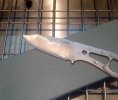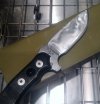What is your preferred grit for profiling and what are the trade-offs between using lower or higher profiling grits?
I've tried everything from my new 140 Atoma, a cheap 150 sk11, a 220 DMT XC, a 300 Ultrasharp, a 325 DMT C, and the 400 Arctic Fox. All worked great for creating the profile. On some I was even able to get the blade shaving sharp at the profiling stage.
Taking a guess at some of the trade-offs:
I've tried everything from my new 140 Atoma, a cheap 150 sk11, a 220 DMT XC, a 300 Ultrasharp, a 325 DMT C, and the 400 Arctic Fox. All worked great for creating the profile. On some I was even able to get the blade shaving sharp at the profiling stage.
Taking a guess at some of the trade-offs:
- Using your higher-grit stones for profiling in a sense would wear them out faster, because you'd have to do more grinding (or use more pressure) to remove the same amount of metal.
- Using lower grits stones creates a very coarse scratch pattern, and if you started at a really low grit, it will probably take a lot of work at higher grits to remove that coarse pattern.
- So are we talking a Goldlilocks solution here? We need the grit that is "just right" to start for profiling? There has to be a range of grits that is just about the right balance between removing metal quickly, but not creating SUCH a coarse scratch pattern that it takes extra work to remove it.


